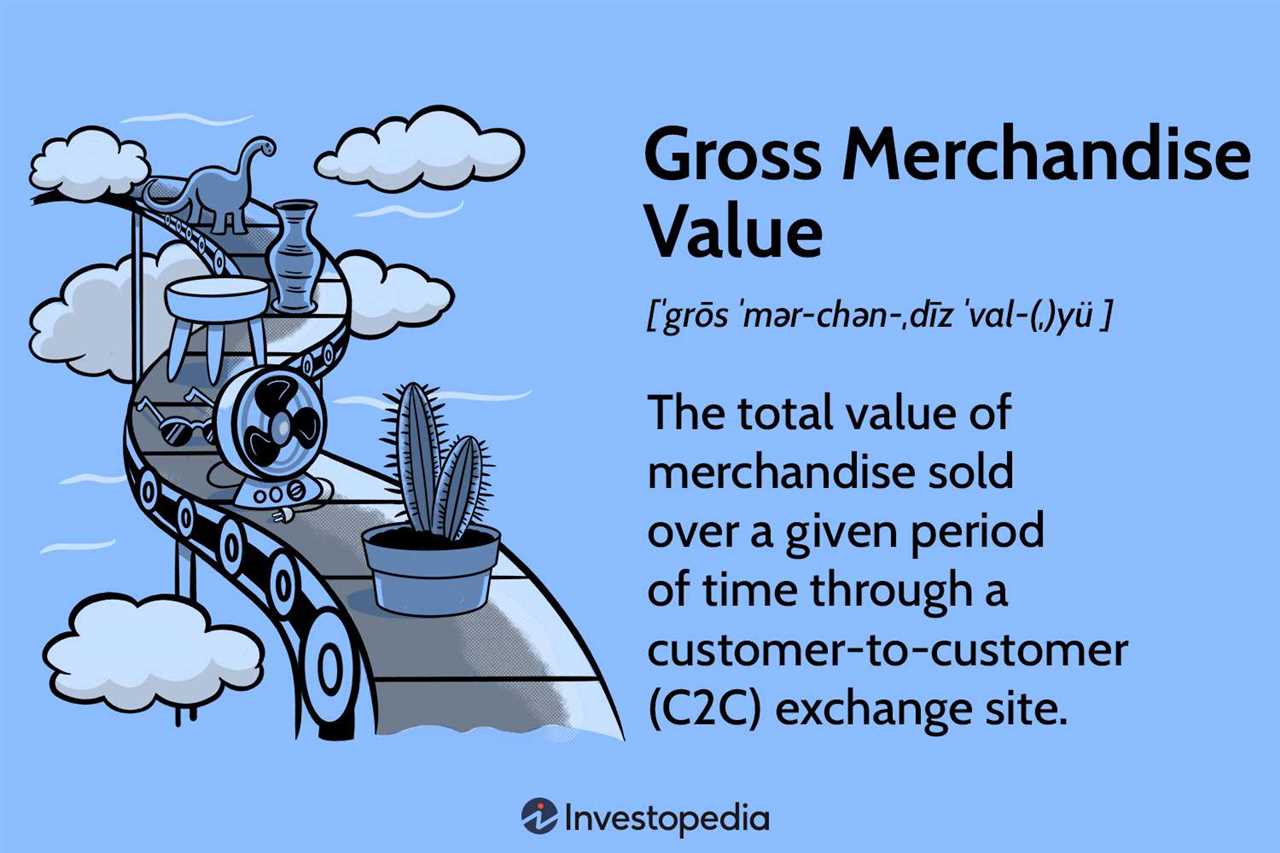Gross Merchandise Value (GMV): Definition, Formula, Pros and Cons, and Example
Gross Merchandise Value (GMV) is a metric used in e-commerce to measure the total value of goods sold through a platform or marketplace. It provides insights into the overall performance and growth of the business by considering the total value of transactions, regardless of any fees or discounts.
Definition
GMV represents the total value of all goods sold within a specific time period. It includes the price of the product, any additional fees, and shipping costs, but excludes taxes and discounts. GMV is often used by e-commerce companies to evaluate their market share, track sales growth, and assess the effectiveness of their pricing strategies.
Formula

The formula to calculate GMV is:
GMV = Total Price of Goods Sold + Additional Fees + Shipping Costs
For example, if a company sold $100 worth of products, charged $10 in additional fees, and incurred $5 in shipping costs, the GMV would be $115.
Pros of Using GMV as a Metric
Using GMV as a metric offers several advantages:
- Comprehensive measurement: GMV provides a holistic view of a company’s sales performance by considering the total value of transactions.
- Easy to calculate: The formula for GMV is straightforward and can be easily calculated using available data.
- Useful for benchmarking: GMV allows companies to compare their performance with competitors and industry benchmarks.
- Reflects growth potential: As GMV measures the total value of goods sold, it can indicate the growth potential of a business.
Cons of Using GMV as a Metric
Despite its benefits, GMV has some limitations:
- Does not account for profitability: GMV does not consider costs, such as production, marketing, and operational expenses, which can impact the overall profitability of a business.
- Does not reflect customer behavior: GMV does not provide insights into customer behavior, such as repeat purchases or average order value.
Example of GMV Calculation
Let’s consider an example to illustrate the calculation of GMV:
A company sold 100 units of a product at a price of $10 per unit. They charged an additional fee of $1 per unit and incurred $50 in shipping costs. The GMV can be calculated as follows:
GMV = (100 units * $10 per unit) + (100 units * $1 additional fee) + $50 shipping costs
GMV = $1000 + $100 + $50 = $1150
Therefore, the GMV for this example is $1150.
What is Gross Merchandise Value (GMV)?
Gross Merchandise Value (GMV) is a metric used in e-commerce to measure the total value of goods sold through a platform or marketplace over a specific period of time. It represents the total dollar value of all transactions, including the price of the products sold, any shipping fees, and any applicable taxes.
GMV is an important metric for e-commerce businesses as it provides a comprehensive view of the overall sales volume and growth of the platform. It helps businesses understand the total value of goods being transacted and can be used to track the performance of the platform over time.
GMV is calculated by multiplying the total number of products sold by their respective prices. For example, if an e-commerce platform sells 100 products at $10 each, the GMV would be $1,000.
GMV Formula: How is GMV Calculated?
Gross Merchandise Value (GMV) is a metric used to measure the total value of goods sold through a marketplace or e-commerce platform. It provides insight into the overall sales performance and growth of a business. Calculating GMV involves considering the total value of all goods sold during a specific time period, regardless of any discounts or returns.
The formula for calculating GMV is relatively straightforward:
GMV = Quantity Sold * Price per Unit
For example, let’s say an e-commerce platform sells 100 units of a product at $10 each. The GMV would be:
GMV = 100 * $10 = $1000
By tracking GMV over time, businesses can evaluate their sales growth and identify trends or patterns. It can also be used to measure the effectiveness of marketing campaigns or promotional activities. Additionally, GMV can help businesses determine their market share and make informed decisions regarding pricing strategies and inventory management.
Pros of Using GMV as a Metric

Gross Merchandise Value (GMV) is a commonly used metric in the e-commerce industry to measure the total value of goods sold through a platform or marketplace. There are several advantages to using GMV as a metric:
1. Comprehensive Measurement
2. Easy Calculation
Calculating GMV is relatively simple and straightforward. It involves multiplying the total number of items sold by their respective prices. This makes it easy for businesses to track and analyze their sales data.
3. Reflects Market Growth
4. Comparison Across Time Periods
By using GMV as a metric, businesses can easily compare their sales performance across different time periods. This allows them to identify trends, patterns, and seasonality in their sales data, which can inform their strategic decision-making.
5. Useful for Valuation
GMV is often used as a key metric in valuing e-commerce businesses. Investors and potential buyers look at GMV to assess the size and growth potential of a company. A higher GMV can indicate a more valuable and attractive business.
Cons of Using GMV as a Metric
While Gross Merchandise Value (GMV) can be a useful metric for measuring the total value of goods sold on a platform, it also has its limitations and drawbacks. It is important to consider these cons when using GMV as a metric for evaluating the performance of a business or platform.
1. Excludes Returns and Discounts
2. Ignores Profitability
3. Doesn’t Reflect Customer Satisfaction
GMV does not provide any insights into customer satisfaction or the quality of the goods sold. It only measures the monetary value of the transactions. This means that a high GMV does not guarantee customer loyalty or repeat purchases. It is important to consider other metrics, such as customer satisfaction surveys or repeat purchase rates, to get a more holistic view of the business’s performance.
4. Vulnerable to Manipulation
Since GMV is a metric that focuses on the total value of goods sold, it can be vulnerable to manipulation. Businesses may engage in practices such as inflating prices or encouraging bulk purchases to increase their GMV artificially. This can lead to a distorted view of the business’s actual performance and may not accurately reflect its true value.
5. Limited Scope
Example of GMV Calculation
Let’s consider an example to better understand how Gross Merchandise Value (GMV) is calculated. Suppose you are running an e-commerce platform where you sell various products. In a given month, you have sold the following items:
Item 1: T-shirt
Quantity sold: 100
Price per unit: $20
Item 2: Smartphone
Quantity sold: 50
Price per unit: $500
Item 3: Handbag

Quantity sold: 80
Price per unit: $100
To calculate the GMV, you need to multiply the quantity sold by the price per unit for each item and then sum up the values.
For Item 1:
GMV for Item 1 = Quantity sold * Price per unit = 100 * $20 = $2000
For Item 2:
GMV for Item 2 = Quantity sold * Price per unit = 50 * $500 = $25000
For Item 3:
GMV for Item 3 = Quantity sold * Price per unit = 80 * $100 = $8000
Now, to calculate the total GMV for the month, you sum up the GMV values for each item:
Total GMV = GMV for Item 1 + GMV for Item 2 + GMV for Item 3 = $2000 + $25000 + $8000 = $35000
Therefore, the Gross Merchandise Value (GMV) for the given month is $35000.
GMV is a useful metric for e-commerce businesses to track their overall sales performance and measure the total value of goods sold. It provides valuable insights into the revenue generated by the business and helps in making strategic decisions.

Emily Bibb simplifies finance through bestselling books and articles, bridging complex concepts for everyday understanding. Engaging audiences via social media, she shares insights for financial success. Active in seminars and philanthropy, Bibb aims to create a more financially informed society, driven by her passion for empowering others.
